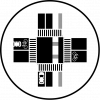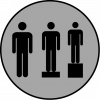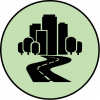
1. Presentation
Intersections in the road network should be designed in such way the cycling, walking and motorized traffic coexist safely and efficiently. The configuration of intersections should link the cycling routes offering route coherence, comfort, safety and accessibility. It may include elements such as colour, signage, medians and pavement markings. Such design should take into consideration the movements of all transport modes.
2. Objectives
- Making intersections safe and comfortable for cyclists;
- Reducing the number of potential conflict points (between cyclists, pedestrians and motorized vehicles);
- Reducing the risk of collisions and the number of accidents;
- Promoting continuity of cycle paths, increasing bicycle competitiveness.
3. Measure’s Importance
Intersections designed for cyclists are essential for reducing potential conflicts with motorized vehicles, ensuring an increased level of visibility, safety and awareness and denoting a clear priority for bicycle users. The degree of mixing or separation between cyclists and other modes is intended to reduce the risk of collisions and increase cyclists’ comfort.
1. Good Practices
– On a local access road, the simplest and most agreeable approach for cyclists is right-of-way mixed traffic, allowing cyclists to mix with motorized traffic for crossing and turning left or right. However, in starter cities, where cyclists are less common, motorists may be reluctant to give way to cyclists. It is necessary to clarify the cyclist’s rights and awareness campaigns are recommended (see Education for mobility in a bicycle environment).
– The design approach varies according to the road hierarchy of intersection branches:
- Two local access roads intersect – little extra provision is needed for cyclists on the intersection;
- A local access road intersects with a priority road – if the priority road tends to have high speeds, traffic calming measures may be considered, such as narrowing the carriageway before the intersection, elevating the intersection and signage. As the traffic intensity increases, special provisions are required, such as traffic islands for cyclists.
- When cyclists are on the priority road, they have the priority. Legally, priority legislation, signs and road markings are enough, but driver may not be aware of cyclists’ priority, hence, it is recommended that the pavement or cycle lane markings remain in the intersection zone, reinforcing the priority rules.
- On cycle paths on a priority road when approaching the intersection, in order to reduce the risk of approaching and exiting the intersection, two solutions are recommended: initiating the approach and exit 15 to 25 m before and after the intersection; alternatively, if there are visibility problems, the crossing of the cycle lane should be moved away at a distance of at least 10 m.
– Two critical comfort design issues should be considered:
- All curve radii for cyclists should be 5 m at least. Below this, the cyclist needs to slow down to 12 km/h and has difficult to maintain stability. On link bends, 10 m allows for a speed of 20 km/h, 20 m for 30 km/h.
- All transitions between different materials should be smooth and without any difference in level (PRESTO, 2010a).
– Monitor citizens’ adaptation to changes and reformulate measures to respond to users’ needs, without compromising sustainable ideals (See Management, monitoring and maintenance).
– Explain the principles behind the measures taken so that their need and functioning are clear (See Information).
2. Actions
 | Bike box Priority area delimited in the motorized traffic forefront at a signalled intersection. Learn more: https://nacto.org/publication/urban-bikeway-design-guide/intersection-treatments/bike-boxes/ Advantages Provides visibility and safety to cyclists, advancing the cyclists flow during the red light phase. Groups cyclists at the intersection, minimizing traffic conflicts. Disadvantages: Costs. |
 | Two Stage Bicycle Turning Box Priority area marked at the road intersection for cyclists who need to change the travel direction (left or right), at the next signalling. Learn more: www.bikecleveland.org/bike-cle/news/tsbtb-omg/2017/10/ Advantages: Provides safety for bicycles and vehicles to keep their regular routes without conflicting with cyclists who are manoeuvring new directions. Disadvantages: Costs. |
 | Cycle crossing Cycle crossing on intersections guides cyclists through a safe and direct route, with a clear visual boundary reinforcing the circulation priority given to the cyclists. Learn more: nacto.org/publication/urban-bikeway-design-guide/intersection-treatments/intersection-crossing-markings/ Advantages: Reduces conflicts between drivers and cyclists, as there is an increase in the visibility level and bicycles’ routes become more predictable. |
 | Central Refuge Island Central refuge islands are protected spaces placed in the centre of the street to facilitate bicycle and pedestrian crossings. Learn more: nacto.org/publication/urban-bikeway-design-guide/intersection-treatments/median-refuge-island/ Advantages: Reduces the overall crossing length and exposure to vehicle traffic. Holds a traffic calming function by physically narrowing the street and potentially restricting the movements of motor vehicles. Disadvantages: Costs. Space consumption. Refuge islands may collect road detritus and may require somewhat frequent maintenance. |
 | Mixing zone/ Combined Bike Lane-Turn Lane Places a suggested bike lane within a dedicated motor vehicle turn lane. Shared lane markings and/or conventional bicycle stencils can delineate the space for bicyclists and motorists within the shared lane or indicate the intended path for through bicyclists. When configured on a cycle track corridor, the combined lane is commonly called a mixing zone, and is intended to minimize conflicts with turning vehicles as an alternative to an exclusive bike signal phase. Learn more: nacto.org/publication/urban-bikeway-design-guide/intersection-treatments/combined-bike-laneturn-lane/ Advantages: Allows cyclists to position themselves before the intersection in order to reduce conflicts with drivers. Disadvantages: Markings within the shared lane will require regular maintenance and marking repairs duet to frequent wear from motor vehicle use. |
 | Intersection with dedicated signalling Timing signalling for the priority circulation of cyclists. Learn more: nacto.org/publication/urban-bikeway-design-guide/bicycle-signals/bicycle-signal-heads/ Advantages: Can eliminate the conflict between motor vehicles and bicycles at the intersections, as the cyclist advances safely in the road, minutes ahead than motorized traffic. Disadvantages: Space consumption. Waiting time for cyclists and drivers. |
Note: In certain situations, when there is already a great number of cyclists, the construction of bridges or tunnels exclusively for bicycles may be considered, particularly on dangerous roads, with very heavy motor traffic, and in situations with physical obstacles (such as railways or rivers).
1. Impacts
 | Mobility system efficiency Provision of cycling intersections can foster the increase of cycling modal share and contributes to increased safety. On the long-term, the expected modal shift of motorized users to the bicycle will result in less congestion and increased efficiency of the mobility system. |
 | Livable streets The provision of cycling intersections promotes the restructuring of public spaces in order to avoid conflict with motor vehicles. The increasing cycling levels will help to reduce noise and air pollution. |
 | Protection of the environment The reduction of car use, as a result of the introduction of cycle intersection and increased safety and connectivity, decreases the levels of air and noise pollution, including reduced CO2 emissions. |
 | Inclusion, equity and accessibility Some groups of people with lower incomes may benefit from the improved low cost mobility option that cycling provides. Provision of secure and safe cycling Intersections is essential to make the modal accessible to the most diverse social and economic strata. |
 | Safety and comfort Provision of cycling Intersections directly enhances safety and comfort. |
 | Economic value The provision of quality cycling intersection infrastructure in a local centre may, only indirectly, encourage greater use of shops and services in the local area. |
 | Awareness and acceptability The provision of cycling intersection promotes increased public awareness, since cyclists’ visibility increases, accompanied by the signalized priority and safe circulation. |
Legend:
| Very positive | Positive | Neutral | Negative | Very negative |
2. Barriers
 | Legal In most cases there are no obvious legal barriers to the provision of Cycling Intersections. The road hierarchy, direction and the intensity of the motorized flow must be taken into consideration in the definition of the infrastructure. |
 | Finance Cycling intersection options do not vary significantly, and most interventions involve signalling for traffic control and safety maintenance, hence they do not represent very significant costs. |
 | Governance It may involve public authorities and potentially corporations, cycling charities and other interest groups. |
 | Political acceptability Measures related to cyclists often have less priority than measures related to motorized vehicles. |
 | Public acceptability Support from a range of groups and pro-cycling lobbies is expected, but also opposition to significant investment in cycling, particularly if this is at the expense of other transport modes or other public services. |
 | Technical feasibility The technical requirements for the implementation of cycling intersections are not complex but demand prior study of traffic dynamics. |
Legend:
| No barrier | Minimum barrier | Moderate barrier | Significant barrier |
3. Budget
| Area | Measure | Unit | Cost | Implementation year |
| Birmingham, U.K | Construction of intersections | Crossing with dedicated signalling for cyclists | 0,41 million £ | Data from a 2017 study |
| Norwich, U.K | Construction of intersections | Crossing for cyclists segregated from pedestrians, including a new signalling | 0,14 million £ | Data from a 2017 study |
| Bristol | Construction of intersections | Roundabout redesign involving the elimination of bus lanes and the placement of signs for cyclists and pedestrians | 0,41 million £ | Data from a 2017 study |
Case Study 1: The Netherlands
In the Dutch case, the protected cycle tracks alongside main streets are continuous at the intersections, so that a junction can be crossed by people of all ages and abilities in a safe and convenient way. The cyclist and the pedestrian always have right-of-way over the car at intersections.
Impacts:
 | Mobility system efficiency The total waiting time is around one minute, which keeps traffic flow high and discourages red light jumping. The Dutch traffic signals at intersections work in a more sophisticated and complex way of creating signal phases. Then, the traffic can work in completely different directions, especially for cyclists, who can have green at the same moment together with pedestrians, or cars turning in another direction. |
 | Livable streets No data. |
 | Protection of the environment No data. |
 | Inclusion, equity and accessibility No data. |
 | Safety and comfort According to several studies, the Dutch design at intersections has proven to be safer, since it reduces conflict with motor vehicles. The tight dimensions decrease the motor vehicles speeds to 20km/h, making the crossing safer. These solutions eliminate high-speed right-angle collisions. |
 | Economic value No data. |
 | Awareness and acceptability No data. |
Case Study 2:Crossing facilities at intersections – New York (U.S.A.)


The cycling strategic planning is recent in New York, and since 2014 significant investments have been made towards the construction of protect and segregated bicycle paths. The new bike network has intrinsic urban design challenges to create a safe environment for cyclists, as 89% accidents involving cyclists happen at road intersections. The DOT project reformulated 20 of the most dangerous intersections in the city, developing 4 solutions to guarantee the safety circulation for cyclists: Mixing zone; Fully Split Phase Signal; Delayed Turn and Offset Crossing.
Learn more: http://www.nyc.gov/html/dot/downloads/pdf/cycling-at-a-crossroads-2018.pdf
Impact:
 | Mobility system efficiency The solutions developed, besides reducing road accidents, include measures that increase the cyclist’s visibility in the traffic, clarifying the priority given to each mode of transport and reducing the speed of motorized vehicles. The case study did not report an increase in congestion and/ or traffic after the implementation of cycling crossings. |
 | Livable streets Providing safe crossings at the most dangerous intersections in New York City contributed to increasing the use of cycle paths for commuting, services and leisure trips. As a result, streets have become more active and dynamic, with a visible interaction of different modes of transportation and social profiles. |
 | Protection of the environment New York city is committed to increasing cycling mobility through an ongoing investment in redesigning road intersections, creating safe conditions for bicycle use. Although the study case does not highlight a reduction in CO2 emissions, increasing traffic safety encourages cycling and the protection of the environment. |
 | Inclusion, equity and accessibility The DOT Project prioritized the redesign of 20 intersections in the city, considered as the most dangerous for pedestrians and cyclists. However, this number is still very small since there are thousands of crossings in New York. |
 | Safety and comfort There was a decrease of 30% in the number of collisions and accidents at intersections involving cyclists. A study found that around 65% of cyclists felt safe riding along the “Mixing Zones” and “Delayed Turn Locations”. The greatest sensation of comfort was reported at the “Offset crossing” typology with 93% of agreement. Overall, the results show that “Mixing zones” and “Fully Split Phase” have substantially reduced the number of accidents between cyclists and motorized vehicles. |
 | Economic value Enhancing traffic safety for cyclists can encourage cycling in the city’s primary and secondary centres, stimulating the local economy in stores and services. However, the case study did not present evidence on this matter. |
 | Awareness and acceptability A survey conducted by Transportation Nation indicates the number of cyclists in the city is increasing gradually, while the number of road accidents involving cyclists and cars has decreased. The increase of cyclist’s visibility and measures regarding road design generate public awareness of cycling as an effective mode of transport. |
Case Study 3: Bicycle Tunnels – Davis (USA)

The Davis’s Cycle Plan has incorporated a large number of bike and pedestrian tunnels to provide safe and efficient routes for bicyclists. Most of the tunnels connect the “Green Routes”, which are usually streets with marked bike lanes connecting popular destinations in the city. Likewise, other tunnels are located within university campuses, offering safe and direct routes for those who use the bicycle in commuting trips.
Learn more: https://cityofdavis.org/home/showdocument?id=2690
Impact:
 | Mobility system efficiency The city of Davis presents a considerable set of bicycle tunnels distributed in the road network, which provides not only an efficient and safe circulation for cyclists, but also enjoyable landscaping. Furthermore, it integrates cycling into the local and regional public transport network. |
 | Livable streets The system of bike tunnels has proved to be immensely popular, promoting use of bicycle as a secure, fast and effective transport mode. However, they are not located in the city centre, thus is not directly linked to the livable streets concept. Many bike tunnels are located along the Greenbelt, which includes beautiful landscaping; others have been used as art panels within the street art movement, contributing to humanize and give life to the city. |
 | Protection of the environment Most bike tunnels are located along the Greenbelt, which is composed of more than ten distinct interconnecting greenbelts. This area refers to the nearly continuous segments of parks and bike paths that stretch across north, south, east and west Davis. The cycling infrastructure and bicycle usage are directly linked to the mitigation of CO2 levels and protection of the environment, since there are more than sixty miles of greenbelt in ten square miles of the city. |
 | Inclusion, equity and accessibility Most tunnels in Davis has large flows of students. The university campus and the city are separate districts, but their bicycle networks are intended to be complementary and cohesive. The infrastructure makes the bicycle as a viable transportation mode and available to all sectors of the community, and specially students. |
 | Safety and comfort The bicycle tunnels in Davis provide safe and continuous routes for students riding to the university campuses, as well as commuters who travel along the cycling network. This measure provides an efficient alternative for cyclists who avoid riding along high-speed roads and dangerous intersections. It represents a complete segregation between cyclists and motorized vehicles. |
 | Economic value No data. |
 | Awareness and acceptability The city’s commitment to building a bike-friendly environment has contributed to the definition of educational, promotional and encouragement strategies to enhance bicycle´s attractiveness. A research revealed that Davis has few cycling barriers – physical or psychological. The wide civic support to the implemented measures and the continuous expansion of infrastructure expansion are representative of achieving a bicycle culture. |
Legend:
| Very positive | Positive | Neutral | Negative | Very negative |
NACTO. National Association of City Transportation Official. (2013). Major Street Crossings. Urban Bikeway Design Guides. Accessed 18 December 2018. Available at: https://nacto.org/publication/urban-bikeway-design-guide/bicycle-boulevards/major-street-crossing/#design
Bicycle Dutch. (2014). Junction design in Netherlands. Accessed 18 December 2018. Available at: https://bicycledutch.wordpress.com/2014/02/23/junction-design-in-the-netherlands/
Bicycle Dutch. (2011). Junction design the Dutch – cycle friendly way. Accessed 11 January 2019. Available at:www.youtube.com/watch?v=FlApbxLz6pA
PRESTO. Promoting Cycling for Everyone as a Daily Transport Mode (2010a). Right-of-way intersections. 25 PRESTO Implementation Fact Sheets. Accessed 1 July 2019. Available at: ec.europa.eu/energy/intelligent/projects/sites/iee-projects/files/projects/documents/presto_fact_sheet_right_of_way_intersections_en.pdf
PRESTO. Promoting Cycling for Everyone as a Daily Transport Mode (2010b). Roundabout intersections. 25 PRESTO Implementation Fact Sheets. Accessed 1 July 2019. Available at: ec.europa.eu/energy/intelligent/projects/sites/iee-projects/files/projects/documents/presto_fact_sheet_roundabout_intersections_en.pdf
PRESTO. Promoting Cycling for Everyone as a Daily Transport Mode (2010c). Traffic-light intersections. 25 PRESTO Implementation Fact Sheets. Accessed 1 July 2019. Available at: ec.europa.eu/energy/intelligent/projects/sites/iee-projects/files/projects/documents/presto_fact_sheet_traffic_light_intersections_en.pdf
Taylor, I. & Hiblin, B. (2017). Typical Costs of Cycling Interventions: Interim analysis of Cycle City Ambition schemes. Accessed 2 July 2019. Available at: www.transportforqualityoflife.com/policyresearch/cyclingandwalking/
